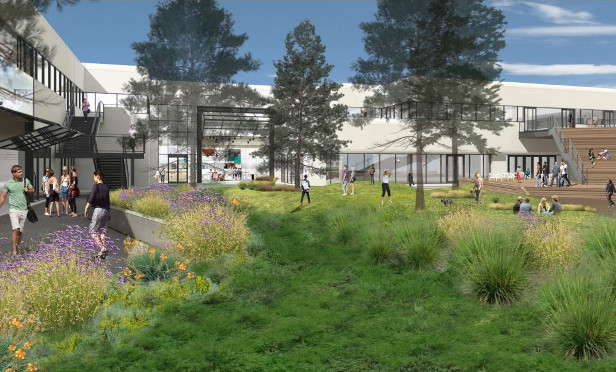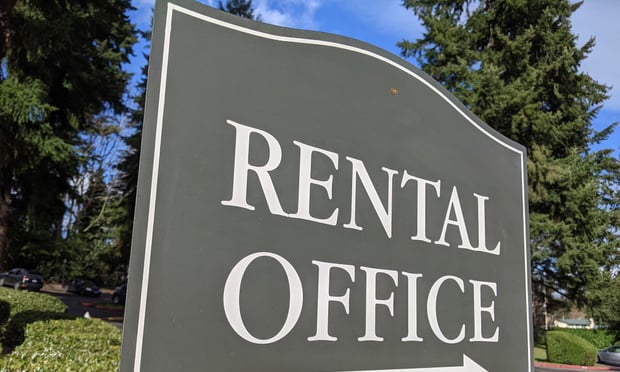
SAN DIEGO—There are three elements that define highly advanced connectivity and telecom infrastructure: choice of provider, redundant infrastructure and readiness to adapt to future technology, WiredScore's director of engineering John Meko tells GlobeSt.com. WiredScore, the world's leading rating system for technological capacity in commercial buildings, recently announced that 9605 and 9645 Scranton Rd. at the Park (formerly the San Diego Tech Center) have achieved Wired Certified Platinum designations for their progressive building technology.
Evaluated on their superior connectivity, technological infrastructure and readiness to adopt emerging technologies, this certification establishes these buildings as the first occupied Wired Certified properties in San Diego.
Lionstone Investments, investment advisors for the owners of the property, along with Locale Advisors, pursued Wired Certification for both buildings. Each building was scrutinized by a team of leading technicians who conducted a rigorous on-site audit, evaluating the number of available Internet service providers, infrastructure redundancy, connection access points and readiness to improve connectivity. The Wired Certification level was assigned based on the official standards developed by WiredScore and its advisory board.
We spoke with Meko about this certification and how it can be achieved economically.
GlobeSt.com: What does it take for a property to achieve the Wired Certified Platinum designation—how much time and effort is needed from the owner/developer involved?
Meko: The process for Wired Certification typically takes 45 to 60 days from start to finish. All that is required on the landlord's end is for them to complete the 10-minute preliminary connectivity survey provided by WiredScore, followed by a scheduled tour with engineers to assess the building. When certifying a new development or redevelopment, teams submit building plans to illustrate the building's connectivity in lieu of a tour. From there, the WiredScore team will do all the heavy lifting, evaluating the property on its connectivity, technological infrastructure and readiness to adopt emerging technologies. All buildings are evaluated on the same criteria and, depending on the results of this evaluation, the building can achieve certification.

GlobeSt.com: Which elements must buildings with a highly advanced technological infrastructure have?
Meko: There are three elements that define highly advanced connectivity and telecom infrastructure: choice of provider, redundant infrastructure and readiness to adapt to future technology. While we focus on these main three factors, there are a number of underlying infrastructure aspects that contribute to this. For choice, WiredScore takes a closer look at the quality and quantity of ISPs offering service to tenants, and the distribution of fiber throughout the building to ensure that it is readily available to tenants. To ensure the building has redundant infrastructure, it may have multiple points of entry or risers that provide back-up service in the event of street-level construction disrupting service or if there is damage to cabling in a section of the building. A building's ability to adopt to future technology will depend on whether they have space in their telecom rooms and capacity at the point of entry and riser to readily accommodate new cabling, hardware or services for future tenants and new technology.
GlobeSt.com: How can achieving this infrastructure be done economically?
Meko: For property owners and developers, the first step is to have a clear understanding of the telecom and connectivity infrastructure currently in place. Many of the teams we work with don't “know what's under the hood” in their buildings; until building owners know what's already in place, they cannot make smart investments to improve or take advantage of existing aspects since they may not be aware of these elements.
To increase understanding on how to design for superior connectivity, WiredScore has published a free, downloadable set of guidelines for developers, architects, and MEP engineers known as Wired Certified Guidelines for Commercial Developments and Redevelopments. The guidelines outline best practices that should be incorporated into building design to meet technology needs and expectations of future tenants. It's truly a great resource for someone looking to make simple changes that can result in a big impact. We advise our development clients that the most cost-effective strategy is to incorporate connectivity during the planning and design process, that way you will avoid costly retrofitting in the future. Property owners can also contact WiredScore to take a preliminary connectivity survey with no commitment to sign up to benchmark their property against the competition.
GlobeSt.com: What's the protocol for developers and owners who wish to achieve a highly advanced technological infrastructure?
Meko: Of course, the best and most effective way to achieve top-tier technological infrastructure is to make it a priority when first constructing a building. This means consulting experts on factors such as adequate planning for the layout of the underground infrastructure, telecom room and riser capacity. Our guidelines are designed to communicate how to implement these measures in the most effective and efficient manner.
But most buildings in today's biggest commercial real estate markets were constructed decades ago and may not be readily equipped with this technology. When we assess buildings, we provide clients with a detailed report describing where and how a landlord can improve its building infrastructure to better promote reliable connectivity.
For example, one of the key distinguishing characteristics that help a building stand out as superior is its ability to provide tenants with multiple forms of resiliency for their telecommunication services. It's essential to provide reliable Internet connections that will not be lost due to factors such as a power failure, street level construction damage, or a coastal flood; many buildings will that don't include these features will need to be retrofitted to incorporate these components.

SAN DIEGO—There are three elements that define highly advanced connectivity and telecom infrastructure: choice of provider, redundant infrastructure and readiness to adapt to future technology, WiredScore's director of engineering John Meko tells GlobeSt.com. WiredScore, the world's leading rating system for technological capacity in commercial buildings, recently announced that 9605 and 9645 Scranton Rd. at the Park (formerly the San Diego Tech Center) have achieved Wired Certified Platinum designations for their progressive building technology.
Evaluated on their superior connectivity, technological infrastructure and readiness to adopt emerging technologies, this certification establishes these buildings as the first occupied Wired Certified properties in San Diego.
Lionstone Investments, investment advisors for the owners of the property, along with Locale Advisors, pursued Wired Certification for both buildings. Each building was scrutinized by a team of leading technicians who conducted a rigorous on-site audit, evaluating the number of available Internet service providers, infrastructure redundancy, connection access points and readiness to improve connectivity. The Wired Certification level was assigned based on the official standards developed by WiredScore and its advisory board.
We spoke with Meko about this certification and how it can be achieved economically.
GlobeSt.com: What does it take for a property to achieve the Wired Certified Platinum designation—how much time and effort is needed from the owner/developer involved?
Meko: The process for Wired Certification typically takes 45 to 60 days from start to finish. All that is required on the landlord's end is for them to complete the 10-minute preliminary connectivity survey provided by WiredScore, followed by a scheduled tour with engineers to assess the building. When certifying a new development or redevelopment, teams submit building plans to illustrate the building's connectivity in lieu of a tour. From there, the WiredScore team will do all the heavy lifting, evaluating the property on its connectivity, technological infrastructure and readiness to adopt emerging technologies. All buildings are evaluated on the same criteria and, depending on the results of this evaluation, the building can achieve certification.

GlobeSt.com: Which elements must buildings with a highly advanced technological infrastructure have?
Meko: There are three elements that define highly advanced connectivity and telecom infrastructure: choice of provider, redundant infrastructure and readiness to adapt to future technology. While we focus on these main three factors, there are a number of underlying infrastructure aspects that contribute to this. For choice, WiredScore takes a closer look at the quality and quantity of ISPs offering service to tenants, and the distribution of fiber throughout the building to ensure that it is readily available to tenants. To ensure the building has redundant infrastructure, it may have multiple points of entry or risers that provide back-up service in the event of street-level construction disrupting service or if there is damage to cabling in a section of the building. A building's ability to adopt to future technology will depend on whether they have space in their telecom rooms and capacity at the point of entry and riser to readily accommodate new cabling, hardware or services for future tenants and new technology.
GlobeSt.com: How can achieving this infrastructure be done economically?
Meko: For property owners and developers, the first step is to have a clear understanding of the telecom and connectivity infrastructure currently in place. Many of the teams we work with don't “know what's under the hood” in their buildings; until building owners know what's already in place, they cannot make smart investments to improve or take advantage of existing aspects since they may not be aware of these elements.
To increase understanding on how to design for superior connectivity, WiredScore has published a free, downloadable set of guidelines for developers, architects, and MEP engineers known as Wired Certified Guidelines for Commercial Developments and Redevelopments. The guidelines outline best practices that should be incorporated into building design to meet technology needs and expectations of future tenants. It's truly a great resource for someone looking to make simple changes that can result in a big impact. We advise our development clients that the most cost-effective strategy is to incorporate connectivity during the planning and design process, that way you will avoid costly retrofitting in the future. Property owners can also contact WiredScore to take a preliminary connectivity survey with no commitment to sign up to benchmark their property against the competition.
GlobeSt.com: What's the protocol for developers and owners who wish to achieve a highly advanced technological infrastructure?
Meko: Of course, the best and most effective way to achieve top-tier technological infrastructure is to make it a priority when first constructing a building. This means consulting experts on factors such as adequate planning for the layout of the underground infrastructure, telecom room and riser capacity. Our guidelines are designed to communicate how to implement these measures in the most effective and efficient manner.
But most buildings in today's biggest commercial real estate markets were constructed decades ago and may not be readily equipped with this technology. When we assess buildings, we provide clients with a detailed report describing where and how a landlord can improve its building infrastructure to better promote reliable connectivity.
For example, one of the key distinguishing characteristics that help a building stand out as superior is its ability to provide tenants with multiple forms of resiliency for their telecommunication services. It's essential to provide reliable Internet connections that will not be lost due to factors such as a power failure, street level construction damage, or a coastal flood; many buildings will that don't include these features will need to be retrofitted to incorporate these components.
Want to continue reading?
Become a Free ALM Digital Reader.
Once you are an ALM Digital Member, you’ll receive:
- Breaking commercial real estate news and analysis, on-site and via our newsletters and custom alerts
- Educational webcasts, white papers, and ebooks from industry thought leaders
- Critical coverage of the property casualty insurance and financial advisory markets on our other ALM sites, PropertyCasualty360 and ThinkAdvisor
Already have an account? Sign In Now
*May exclude premium content© 2025 ALM Global, LLC, All Rights Reserved. Request academic re-use from www.copyright.com. All other uses, submit a request to [email protected]. For more information visit Asset & Logo Licensing.








